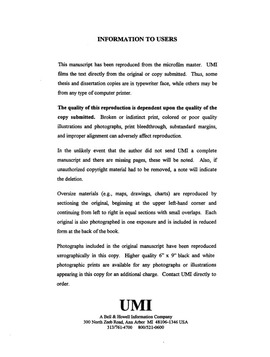| dc.contributor.advisor | McCann, Patrick John, | en_US |
| dc.contributor.author | Strecker, Brian Noel. | en_US |
| dc.date.accessioned | 2013-08-16T12:30:03Z | |
| dc.date.available | 2013-08-16T12:30:03Z | |
| dc.date.issued | 1998 | en_US |
| dc.identifier.uri | https://hdl.handle.net/11244/5645 | |
| dc.description.abstract | This dissertation describes experiments undertaken to develop techniques required to develop IV-VI lasers grown on silicon. A review of the IV-VI materials system, diode laser structures, recent IV-VI laser results, epitaxial growth techniques, and thermal modeling results introduces the reader to the structures and materials to be discussed. Designs for three different IV-VI laser structures on silicon follow. Three types of experimental structures are investigated next: those grown on BaF$\sb2$ substrates by liquid phase epitaxy (LPE), those grown on silicon by molecular phase epitaxy (MBE), and those grown on silicon by a combination of MBE and LPE. The author's recommendations for future work sum up the body of the text. Five appendices are included to document procedures (BaF$\sb2$ chemical mechanical polishing and IV-VI material preparation for LPE), to provide supplementary material (cleaving jig preparation for epitaxial lift-off of IV-VI layers and the effects of oxygen adsorption upon IV-VI materials), and to act as a repository for program code generated during this project (six programs and their supporting code for acquiring, displaying, and converting measurement data). | en_US |
| dc.description.abstract | Fabrication of commercially competitive IV-VI tunable diode lasers has been hampered by lack of suitable substrates. Lasers grown on IV-VI materials themselves are acceptable for low temperature operation, but poor substrate thermal conductivity limits their operation to the cryogenic regime. An alternative substrate material, BaF$\sb2, $ is a promising alternative, but available substrates are often of questionable crystalline quality. High quality silicon, however, is readily available and may be used to grow epitaxial BaF$\sb2.$ This BaF$\sb2$ epilayer may then be used as a substrate for further growth of IV-VI diode lasers. In addition, the water solubility of BaF$\sb2$ permits lift-off of the laser structures and remounting on a more electrically and thermally accommodating substrate--such as copper. | en_US |
| dc.format.extent | xix, 189 leaves : | en_US |
| dc.subject | Epitaxy. | en_US |
| dc.subject | Engineering, Electronics and Electrical. | en_US |
| dc.subject | Semiconductor lasers. | en_US |
| dc.subject | Tunable lasers. | en_US |
| dc.subject | Engineering, Materials Science. | en_US |
| dc.subject | Silicon. | en_US |
| dc.subject | Diodes, Semiconductor. | en_US |
| dc.title | IV-VI semiconductor structures for laser fabrication of silicon. | en_US |
| dc.type | Thesis | en_US |
| dc.thesis.degree | Ph.D. | en_US |
| dc.thesis.degreeDiscipline | School of Electrical and Computer Engineering | en_US |
| dc.note | Adviser: Patrick John McCann. | en_US |
| dc.note | Source: Dissertation Abstracts International, Volume: 59-04, Section: B, page: 1790. | en_US |
| ou.identifier | (UMI)AAI9828798 | en_US |
| ou.group | College of Engineering::School of Electrical and Computer Engineering | |
